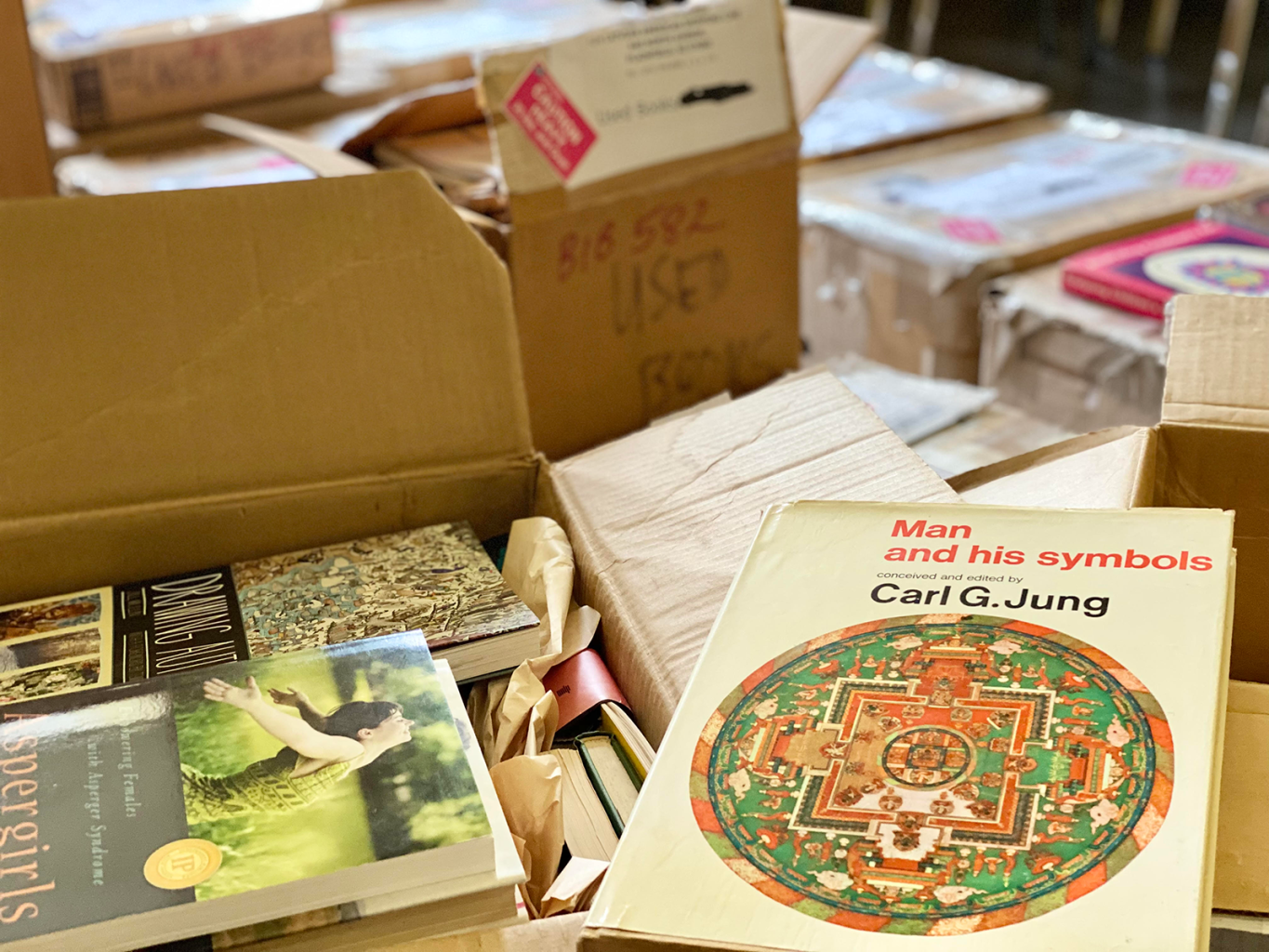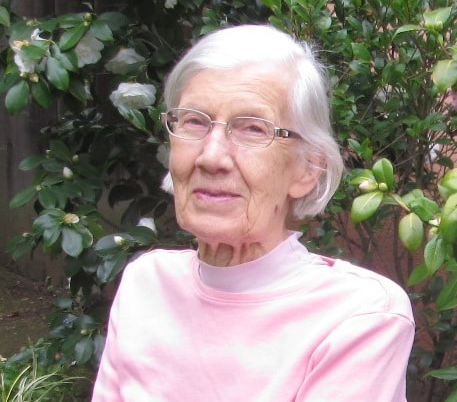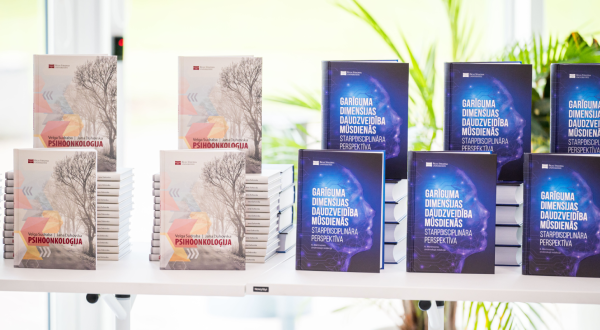RSU library receives collection of valuable art therapy books
Vija Bergs-Lusebrink, a Latvian-born art therapist from the US, passed away in the summer of 2022 at the age of 97. She bequeathed her long-established library of books to Prof. Kristīne Mārtinsone, Head of the Department of Health Psychology and Paedagogy at Rīga Stradiņš University (RSU).
At the beginning of 2023, 15 boxes of books arrived in Latvia from the US, including many valuable books, some of them not available elsewhere. These books covered topics related to the functioning of the human brain and its connection to art, symbols, myths in art, art therapy, and using of art therapy with different patient groups.

Some of the books in the collection.
Photo: Elīna Akmane
Prof. Mārtinsone presented this valuable donation to the RSU library with gratitude and joy so that students and faculty members have the opportunity to use these books in their research and their practical and academic work.
We fondly remember Bergs-Lusebrink, PhD, a professor emerita at the University of Louisville and an honorary member of the American Art Therapy Association. For over thirty years, she made significant contributions to the field of art therapy, particularly with her model known as the Expressive Therapies Continuum, which is based on the latest psychology and neuroscience research on information processing. The model is used by art therapists around the world. Bergs-Lusebrink was an enthusiastic researcher and collaborated extensively with professors and students at RSU throughout her life, supporting them in their research. She was an adviser on the publication of a book on art therapy in Latvian and was an honorary member of the Latvian Art Therapy Association.
Below is an interview with Bergs-Lusebrink from the book Mākslas terapijas izglītības desmit gadi Rīgas Stradiņa universitātē. No ieceres līdz profesijai (compiled by J. Duhovska and K. Mārtinsone, Riga, RSU, 2016), dedicated to the tenth anniversary of the RSU Art Therapy study programme.
The creative spirit associated with art therapy paves the way
How did you get involved in art therapy and what was your motivation?
Since ancient times, people have understood that art has healing properties - whether it is fine arts, dance, or music. Art therapy as a healing discipline in the field of medicine or therapy is relatively new; the field, both in practice and literature, only started emerging in the 1960s. I came to art therapy via a winding path, much like many art therapists. I was fortunate to be in California in the late 1960s and participate in the so-called creative self-awareness and actualisation movement.

Vija Bergs-Lusebrinka.
Photo: The Kentucky Art Therapy Association
I was born in Riga, in free Latvia, between the two world wars. I had always loved drawing and art, but I planned to study medicine and become a doctor like my father. Unfortunately, life took a different course than I had hoped. To avoid being deported to Siberia in the final stages of WWII, my mother, sister and I fled to Germany, which is where I began to study chemistry as a possible step towards medical studies. The road back to Latvia was closed because of the continued threat of deportation, but several years later we had the opportunity to move to the US. Here, I obtained a bachelor's degree in chemistry from the University of Nevada and met my future husband, a Californian. After the birth of my three daughters, I returned to my "first love" - art - and obtained a master’s degree in art from the University of California, Berkeley.
I discovered art therapy in the late sixties at a self-exploration meeting, where non-verbal forms of expression through various art forms and movement were used. As an artist, I was also teaching, so that I would be able to understand what others were expressing through their drawings. It was then that I decided that I wanted to become an art therapist! There were no schools that taught art therapy in the US at the time, but fortunately I lived in Palo Alto near Stanford University. Here, I could find some books on patients' visual expressions in the library, two books on art therapy, and the Bulletin of Art Therapy (now called The American Journal of Art Therapy), which has been published since the early sixties on the US east coast. I started studying psychology and found a job in a psychiatric hospital where I worked as an art therapist. In between, I also met my mentor Jenny Ryan, a Gestalt art therapist. After several years of working on this project, I began teaching art therapy at the University of Louisville in Kentucky, where I was also the programme director for twenty years until my retirement. During this time, I obtained an interdisciplinary doctoral degree that combined psychology and psychiatry.
What does art therapy mean to you?
My approach to art therapy was initially "art as therapy", because it was based on my studies and understanding of art, as well as my personal experience of art as a form of creative expression. My patients in the psychiatric hospital were mostly people with chronic schizophrenia or young people experiencing psychotic disorders for the first time. Observing them, I discovered what I had already read in books: if people cannot put what they are experiencing and feeling into words, they use other means of expression, such as art or movement. I also observed that their free and spontaneous visual expressions fell into several categories that had already been described in both literature on psychiatry and art: some expressions were kinesthetically based, some emphasised variations of form, while others were symbolic. I tried to help them understand and integrate their expressions and feelings using artistic means. This gradually led to the concept of expressive art therapy levels. This concept laid the foundations for the Expressive Therapies Continuum that I developed later, which comprises three levels: kinesthetic-sensory, perceptual-affective and cognitive-symbolic. Creative expression may be present at one or more levels, or all of them. This model was developed more from my observations, working with different people with various mental disorders, teaching and observing students in practice, and collaborating with colleagues. I have published my approach to art therapy in the book Imagery and Visual Expression in Therapy (1990), and have written numerous publications and several chapters in books edited by others.
Visual expression in art therapy helps organise a person’s inner feelings, sensations, thoughts and images, giving them a concrete form that can become an anchor for reality when their mental activity becomes scattered, or a starting point for further creative activity. Creative activity and engagement with each person's creative spirit are crucial components of art therapy, as they provide motivation and energy to overcome difficulties, and help revive blocked mental structures or create new healthy internal mental structures, as well as integrate healthy drives related to these. Working with different means of artistic expression affects brain function in different ways, and their healing potential reflects the plasticity of the brain.
What, in your opinion, are the most important events in the development of art therapy in Latvia that you have been involved in?
Looking from a distance, the creation of the art therapy programme at RSU was a very important factor in the development of art therapy in Latvia. Like any new discipline in a country, art therapy needs support in higher education in order to train qualified therapists and increase and disseminate knowledge about the field.
Personally, I began exploring the possibilities of art therapy in Latvia in 1990 when I visited Riga for the first time in many decades and spoke with Imants Plotnieks, a professor of psychology at the University of Latvia. One of his students was interested in studying creativity, but there was no talk of art therapy specifically. In 1998, I was in Riga and Jūrmala for the colloquium of the XXI International School Psychology Association, where I learned that there was interest in art therapy, but no organised plans for introducing art therapy in Latvia.
Ten years later, when I contacted Prof. Mārtinsone, I was amazed and delighted to discover that the many obstacles had been overcome and the first graduation ceremony of art therapists had been held. I was impressed by the programme's broad and contemporary approach to art therapy, which combined art as therapy with the British approach to art psychotherapy. I was also pleased to learn that two two important books on art therapy had been published. I had the pleasure of working with Prof. Mārtinsone and art therapist Ilze Dzilna-Šilova with whom I wrote several publications on art therapy that were published in international journals. I also appreciated that three students wrote master's theses on the Expressive Therapies Continuum!
What is the current role of art therapy and what are the main challenges for its further development?
The Art Therapy programme at RSU is based on medicine and my experience in the field of art therapy. The fact that this programme has been in existence for ten years is a great achievement in the field of art therapy in Latvia. The number of professional art therapists is constantly growing. Art therapy is a relatively new field of therapy, so it is important that these and future therapists continue to expand the use of art therapy in various healthcare sectors. Their experience in practice, the exchange of information within the Latvian Art Therapy Association, publications, and the dissemination of information about art therapy to other healthcare professionals will further expand the field of art therapy and promote its use in different healthcare sectors. This growth and expansion should take place within the field of art therapy research and should incorporate the latest research and findings from other mental health disciplines.
It is important to keep in mind that art therapy is based on artistic expression and the creativity and creative spirit that goes with it. This is what guides and helps us move towards improving mental health, based on the effects of artistic expression on the brain and its plasticity.
Elīna Akmane,
RSU Department of Health Psychology and Paedagogy




